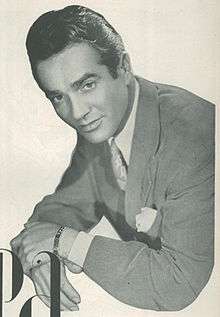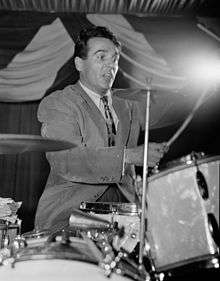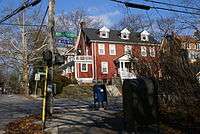Gene Krupa
| Gene Krupa | |
|---|---|
 Gene Krupa in 1944 | |
| Background information | |
| Birth name | Eugene Bertram Krupa |
| Born |
January 15, 1909 Chicago, Illinois, U.S. |
| Died |
October 16, 1973 (aged 64) Yonkers, New York |
| Genres | Jazz, swing, Dixieland |
| Occupation(s) | Musician, composer, bandleader |
| Instruments | Drums |
| Years active | 1920s–1973 |
| Associated acts | Eddie Condon, Benny Goodman, Louie Bellson, Anita O'Day |
Eugene Bertram Krupa (January 15, 1909 – October 16, 1973) was an American jazz drummer, band leader, actor, and composer known for his energetic style and showmanship.[1][2] His drum solo on "Sing, Sing, Sing" (1937) elevated the role of the drummer as a frequently used solo voice in the band.
He is also known for defining the standard drum kit used today in collaboration with brands Slingerland and Zildjian. Krupa is considered "the founding father of the modern drumset" by Modern Drummer magazine.[3]
Early life
The youngest of Anna (née Oslowski) and Bartłomiej Krupa's nine children, Gene Krupa was born in Chicago. Bartłomiej was an immigrant from Poland. Anna was born in Shamokin, Pennsylvania and was also of Polish descent. His parents were Roman Catholics who groomed him for the priesthood. He spent his grammar school days at parochial schools. After graduation he attended Saint Joseph's College for a year but decided the priesthood was not his vocation.
Krupa studied with Sanford A. Moeller and began playing drums professionally in the mid-1920s with bands in Wisconsin. In 1927 he was hired by MCA to become a member of Thelma Terry and Her Playboys, the first notable American jazz band—all-girl bands excepted—to be led by a female musician. The Playboys were the house band at The Golden Pumpkin nightclub in Chicago and toured throughout the eastern and central United States.
Career

Krupa made his first recordings in 1927 with a band under the leadership of Red McKenzie and guitarist Eddie Condon. Along with other recordings by musicians from the Chicago jazz scene, such as Bix Beiderbecke, these recordings are examples of Chicago style jazz. Krupa's influences during this time included Father Ildefonse Rapp and Roy Knapp (both teachers of Gene), and drummers Tubby Hall, Zutty Singleton and Baby Dodds. Press rolls were a fairly common technique in the early stages of his development. There were many other drummers (Ray Bauduc, Chick Webb, George Wettling, Dave Tough) who influenced his approach to drumming and other instrumentalists and composers such as Frederick Delius who influenced his approach to music.[4]
Krupa appeared on six recordings by the Thelma Terry band in 1928. In December 1934, he joined Benny Goodman's band, where his drum work made him a national celebrity. His tom-tom interludes on the hit "Sing, Sing, Sing" were the first extended drum solos to be recorded commercially[5] But conflict with Goodman prompted him to leave the group and form his own orchestra after the Carnegie Hall concert in January 1938.[6] He appeared in the 1941 film Ball of Fire in which he and his band performed an extended version of the hit "Drum Boogie", sung by Barbara Stanwyck (whose singing was dubbed by Martha Tilton). He composed the song with trumpeter Roy Eldridge. As an encore, he played a tamer version of the same song using matchsticks as drumsticks and a matchbox as a drum while Stanwyck and the audience sang along. In 1943, after being arrested for possession of marijuana, he broke up the orchestra and returned to Goodman's band for a year.[6]
As the 1940s ended, Count Basie closed his band and Woody Herman reduced his to an octet. Krupa gradually cut down the size of his band in the late 1940s, and from 1951 on he led a trio or quartet, often with Eddie Shu on tenor sax, clarinet, and harmonica. He appeared regularly in the Jazz at the Philharmonic concerts. He made a cameo appearance in the 1946 film The Best Years of Our Lives. His athletic drumming style, timing methods, and cymbal technique evolved during this decade to adapt to changing fashion, but he never adjusted to the bebop style of jazz.[4]
In 1954, Krupa returned to Hollywood to appear in the films The Glenn Miller Story and The Benny Goodman Story. In 1959, the movie biography The Gene Krupa Story was released; Sal Mineo portrayed Krupa, and the film included a cameo by Red Nichols.[4]
During the 1950s, Krupa often played at the Metropole near Times Square in Manhattan. He continued to perform in famous clubs in the 1960s, including the Showboat Lounge in northwest Washington, D.C. Increasingly troubled by back pain, he retired in the late 1960s and opened a music school. His students included Peter Criss of Kiss[7] and Jerry Nolan of The New York Dolls. Doug Clifford of Creedence Clearwater Revival cited Krupa as an inspiration.[8]
Krupa occasionally played in public in the early 1970s until shortly before his death. One such appearance occurred in 1972 at a jazz concert series sponsored by the New School in New York. Krupa appeared onstage with trumpeter Harry James and the saxophonist Gerry Mulligan. The presumption was that the 500 or so audience members were drawn by Mulligan's contemporary appeal, but when Krupa took a 16-bar break during the second song, audience members leapt to their feet in appreciation.
Krupa-Rich drum battles
Norman Granz hired Krupa and drummer Buddy Rich for his Jazz at the Philharmonic concerts. The two drummers performed at Carnegie Hall in September 1952 and it was issued by Verve as The Drum Battle. The two drummers faced off in a number of television broadcasts and other venues and often played similar duets with drummer Cozy Cole. Krupa and Rich recorded two studio albums together: Krupa and Rich (Verve, 1955) and Burnin' Beat (Verve, 1962).
Personal life
Krupa married Ethel Maguire twice: the first marriage lasted from 1934 to 1942, the second from 1946 to her death in 1955. He remarried in 1959 to Patty Bowler and they were divorced within ten years.
In 1943, Krupa was arrested for possession of two marijuana cigarettes. He was charged with local and federal charges (contributing to delinquency of a minor) and was given a 90-day jail sentence for the first and convicted of the second. He served 84 days of the local sentence (time served for a crime was not guilty of). He was exonerated/acquitted of all charges when it was proven that he was framed, as the prosecution's key witness, John Pateakos had been paid to testify falsely against Krupa. Pateakos returned to prove that he wasn't a minor, that he had dodged the draft, and that he had been instructed by federal agents to leave after the first conviction. He recanted his earlier testimony.
In the early 1970s Krupa's house in Yonkers, New York, was damaged by fire.[9] He continued to live in the parts of the house that were habitable.
In 1973, Krupa died in Yonkers at the age 64 from heart failure, though he also had leukemia and emphysema.[10] He was buried in Holy Cross Cemetery in Calumet City, Illinois.
Endorsement

In the 1930s, Krupa became the first endorser of Slingerland drums. At Krupa's urging, Slingerland developed tom-toms with tuneable top and bottom heads, which immediately became important elements of virtually every drummer's setup. Krupa developed and popularized many of the cymbal techniques that became standards. His collaboration with Avedis Zildjian developed the modern hi-hat cymbals and standardized the names and uses of the ride cymbal, crash cymbal, splash cymbal. He is also credited with helping to formulate the modern drum set, being one of the first jazz drummers (for that recording studio) to use a bass drum, in a recording session in December 1927.[11] One of his bass drums, a Slingerland 14 X 26, inscribed with Benny Goodman's and Krupa's initials, is preserved at the Smithsonian museum in Washington, D.C.[12]
Awards and honors
In 1978, Krupa became the first drummer inducted into the Modern Drummer Hall of Fame. The 1937 recording of Louis Prima's "Sing, Sing, Sing (With a Swing)" combined with Waller's "Christopher Columbus" by Benny Goodman and His Orchestra featuring Gene Krupa on drums was inducted into the Grammy Hall of Fame in 1982.
Discography
As leader
- 1952 The Original Drum Battle (Verve)
- 1952 The Drum Battle with Buddy Rich (Verve)
- 1953 Timme Rosenkrantz' 1945 Concert Vol. 3 (Commodore)
- 1953 The Exciting Gene Krupa
- 1954 Sing, Sing, Sing (Verve)
- 1954 The Driving Gene Krupa (Verve)
- 1954 Gene Krupa, Vol. 1 (Clef)
- 1954 Gene Krupa, Vol. 2 (Clef)
- 1955 The Jazz Rhythms of Gene Krupa (Verve)
- 1955 G. Krupa-L. Hampton-T. Wilson (Verve)
- 1955 The Gene Krupa Quartet (Clef)
- 1956 Drummer Man (Verve)
- 1956 Krupa and Rich (Verve)
- 1957 Krupa Rocks (Verve)
- 1959 Big Noise from Winnetka (Commodore)
- 1959 Plays Gerry Mulligan Arrangements (Verve)
- 1959 Hey...Here's Gene Krupa (Verve)
- 1959 The Gene Krupa Story (Verve)
- 1961 Percussion King (Verve)
- 1962 Burnin' Beat with Buddy Rich
- 1963 The Mighty Two with Louis Bellson (Roulette)
- 1964 The Great New Gene Krupa Quartet Featuring Charlie Ventura (Verve)
- 1972 Jazz at the New School (Chiaroscuro)[13]
As sideman
With Benny Goodman
- 1950 Live at Carnegie Hall (1938)
- 1955 The Benny Goodman Story, Vols. 1–2
- 1956 The King of Swing, Vol. 2
- 1956 Trio Quartet Quintet
- 1997 The Complete RCA Victor Small Group Recordings (RCA Victor, 1935–39 [1997])
References
- ↑ Yanow, Scott. "Gene Krupa". AllMusic. Retrieved 25 September 2018.
- ↑ Spagnardi, Ron (1992). The Great Jazz Drummers. Hal Leonard Corporation. p. 35.
- ↑ "Gene Krupa: The Man Who Made It All Happen". Modern Drummer. Retrieved 2017-01-15.
- 1 2 3 "Gene Krupa profile". Drummerman.net. Retrieved 2011-10-20.
- ↑ Bruce H. Klauber, World of Gene Krupa: That Legendary Drummin' Man, p. 13
- 1 2 J. Pagano Jr. "Gene Krupa Biographies / Gene Krupa". Gkrp.net. Archived from the original on 2002-06-29. Retrieved 2016-03-13.
- ↑ KISS – Behind the Mask, David Leaf and Ken Sharp, 2003, Warner Books, ISBN 978-0446695244
- ↑ Wilkening, Matthew (13 October 2011). "Creedence Clearwater Revival's Doug Clifford discusses his influences, punk rock and Revisited's future". Ultimate Classic Rock. Townsquare Media. Retrieved 7 November 2017.
- ↑ Klauber, Bruce H. (1990). World of Gene Krupa: That Legendary Drummin' Man. Pathfinder . p. 166. ISBN 093479328X.
- ↑ "Drummer Gene Krupa, whose flying sticks symbolized the swing era, died Tuesday after a lengthy illness". St. Petersburg Times. October 17, 1973.
- ↑ "Drummer World: Gene Krupa". Drummerworld.com. Retrieved 2015-01-28.
- ↑ ""Gene Krupa: a Drummer with Star Power" by Owen Edwards". Smithsonianmag.com. Retrieved 2012-06-25.
- ↑ "Gene Krupa | Album Discography | AllMusic". AllMusic. Retrieved 26 September 2018.
External links
| Wikimedia Commons has media related to Gene Krupa. |